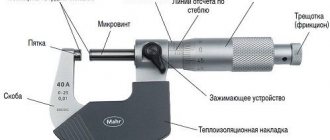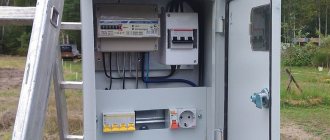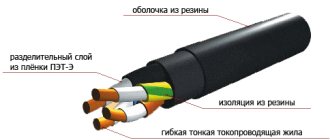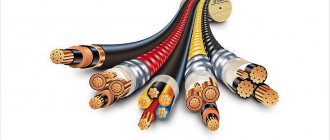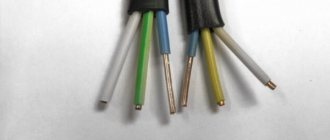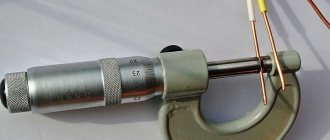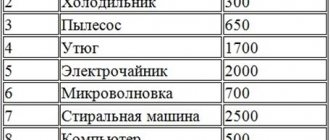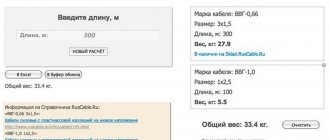To increase the power of the power grid in private homes, it is necessary to replace the wire. Therefore, we figure out what cable is needed to connect a house to a 15 kW electrical network. Let's consider which wire is best to use, how to introduce it into the house and what types there are. We will also decide what cable is needed for connection via air or ground, what should be the distance from the wire to the ground or other nearby objects.
Power supply input Source infoelectrik.ru
Features of 15 kW cable
The product consists of several solid metal cores (the number depends on the number of phases), coated with a layer of protective material. The insulation is characterized by increased elasticity and resistance to external factors. Cables for open wiring are coated with a protective layer that can withstand exposure to ultraviolet light.
The conductors must withstand the rated load without heating and destruction or ignition of the sheath. If SIP category wire is used for switching, then the product design includes a steel load-bearing core.
Types of cables
Products are divided into categories according to:
- number of phases in the power supply network;
- core material and load power;
- the method of laying a main line from a substation or pole to a house.
Three-phase
The wiring for connection to a three-phase network consists of individually insulated metal cores, additionally covered with an outer protective layer. It is distinguished by a reduced cross-section of the cores, but the voltage of 380 Volts is suitable for switching industrial equipment. There are powerful household appliances (for example, electric kitchen stoves) designed for a three-phase network.
A three-phase wire consists of metal conductors insulated.
Single phase
The cable is distinguished by the use of cores for supplying phase, neutral and equipment grounding. The operation of energy-intensive equipment requires an increased cross-section of conductors. Due to the voltage drop, the current is increased to provide the required power, which causes increased heat generation (in accordance with the Joule-Lenz law). Single-phase wire is used when wiring circuits inside the house. The cross section is selected depending on the power of the equipment.
Which one should you choose?
The use of three-phase power supply requires the installation of special protection equipment and a meter in the panel. In return, the home owner receives increased system reliability and a reduced heat load on the supply line. If it is necessary to ensure switching of equipment with a power of up to 15 kW, then only a three-phase incoming line should be used.
A single-phase connection is suitable for houses consuming no more than 7 kW, or for internal wiring of the power supply system.
Which SIP wire to choose for connecting a country house and plot
SIP cable is a reliable and versatile conductor of electric current, which has found a wide area of its direct use. Its versatility lies in the fact that it can be used extremely effectively in a wide variety of situations. It is also characterized by its ease of installation and a wide range of models. But due to their huge variety, many people do not know which SIP wire to choose for their dacha. The article discusses the solution to this issue.
Purpose of SIP cable
This type of cable line can be used in networks of a wide variety of voltages, which can vary from 220 V to 20 kV. The key feature of SIP is the ease of its installation. It does not need reinforcement, holds its shape well and does not sag even under its own weight. Therefore, when laying overhead lines in a country house, it is better to use SIP cable. Also, this type of conductor is characterized by excellent insulation, which eliminates the possibility of a short circuit.
Types of SIP cable and area of use
Today, in the local electrical market, the buyer can find the following types of SIP cable:
- SIP1. Based on the use of several cores, the neutral cable is not insulated;
- SIP2. There are two cores, the neutral cable is insulated, and is used for laying overhead lines. Can be used as main power supply lines between populated areas. Can be used in almost any climatic conditions. When exposed to low temperatures, the insulating layer does not deform. Withstands temperatures up to +900 degrees;
- SIP3. The insulation of this type of cable is based on the use of polyethylene. Also can be used in cold and hot conditions;
- SIP4. This modification of the cable does not have a load-bearing core. The design feature is the use of two or four cores. It is used directly for wiring in the house or supplying electricity to the building itself;
- SIP5. They have a high degree of security and are double insulated. Often used to lay power lines between cities.
As you can see, each type of cable has its own technical and operational characteristics. Depending on the specifics of use, as well as the method of laying the cable line, you can choose for yourself the most optimal option for this practical and reliable electrical conductor. We hope that you now know which SIP wire to choose for your dacha.
The material was prepared with the support of our partner TD "BalticCable"
Selection of cable cross-section for 15 kW
When selecting the cross-section of the cores, the load, the number of phases and the material of the cable cores are taken into account. To roughly determine the parameter, use the standard values indicated in the tables. To protect the wiring from overheating, it is recommended to provide a larger cross-section margin of 10–15%. If you use cables with a core diameter below the permissible value, then at rated load the metal heats up and destroys the insulation, and if overloaded, the wiring burns out or causes a fire in the house.
Aluminum wires
The use of aluminum makes it possible to reduce the cost of cable production, but the metal is not highly elastic and gradually becomes brittle.
The wiring is not suitable for installation on surfaces that support combustion (regardless of the material of the protective screens). Difficulties also arise when joining aluminum and copper conductors; the resulting electrochemical pair is rapidly destroyed (the problem is solved by using special terminals). The table shows the values of the core cross-section depending on the power and number of phases in the network.
| Standard cross-section, mm² | Current and power for 1-phase network | Current and power with 3-phase network |
| 4 | 28/6,1 | 23/15,1 |
| 6 | 36/7,9 | 30/19,8 |
| 10 | 50/11,0 | 39/25,7 |
| 16 | 60/13,2 | 55/36,3 |
| 25 | 85/18,7 | 70/46,2 |
The table allows you to determine which cable is needed for switching at home. For example, with single-phase power, you will need wiring with an aluminum core cross-section of at least 25 mm²; the previous standard value of 16 mm² will withstand about 13 kW.
With three-phase power, you can get by with a cable with a core cross-section of 4 or 6 mm² (the second option increases the reliability of the network).
Copper wires
The use of copper makes it possible to reduce resistance and reduce the cross-section of the cores while maintaining load power.
Answers from experts
vasiliy zelenkov:
What's the voltage? It depends on it, for example, a 2000W kettle is powered by what cord and the starter on a ZAZ is 0.78 kW, and the wiring will be THICKER.
Eugene:
220 - 10 squares is enough, 380 - 4 should be enough (per core)
Seryoga Sribny:
10mm2 copper, open wiring 220V. If closed 16mm2.
Vitaly Petrov:
If the three-phase motor is 380V, the four-core copper cable is 6mm square (each core).
Alexander Zatsarinny:
What kind of load: single-phase or three-phase? Which cable cores are aluminum or copper? How will the cable be laid: along structures, in the ground, in a pipe, or what?
Marina Zhivaga:
Alexandr Yykh:
Every electrician knows that 1 Current follows the path of least resistance. 2 Grounding resistance should be 4 ohms. 3 The wire holds 10 amperes per square. —
The misconception about “amps per square” stems from the fact that most electricians are only familiar with residential wiring where the range of cross-sections ranges from 2.5 mm2 to 6 mm2 and the use of “amps per square” in this case does not make serious mistakes.
But if we use tables from the PUE for determination, we see
that the long-term permissible current of the wire in terms of “amps per square” varies for copper from 15 A/mm2 for a cross-section of 1 mm2, to less than 2 A/mm2 for large sections, and for aluminum from 8 A/mm2 to less than 2 A/mm2. Considering the high price of large cross-section cables, it is better to use PUE tables to select a cable rather than dubious “amps per square”.
In this case, if there are no additional conditions, Table 1.3.5 is suitable. Permissible continuous current for rubber and polyvinyl chloride insulated wires with aluminum conductors
The consumer's cosine phi is not specified in the conditions. If we assume that cosine phi is equal to one, that is, there are almost no motors, almost all the power goes to heating, then
120 kW/(3*0.22 kV)= 180 amperes A three-core aluminum cable 120 mm2 holds 190 amperes, so it’s suitable. A drop of about 5...6 volts at 200 meters does not create a problem. When choosing a cable, do not forget about the zero core.
If there are a lot of motors, then the cosine phi can be somewhere around 0.4...0.5. In this case, the current will be two or more times greater and it will not be possible to get by with just one cable. You can install a reactive compensator directly on the consumer’s tires, but then if it fails, the consumer will not be able to work.
If this is not a course study, but a real installation, then we must not forget to regularly check the heating of the contacts throughout the entire circuit and in case of strong heating, not just crimp, but also clean off the oxide from the aluminum at the point of contact.
bruho:
In general, they dance not from power, but from current... Copper holds approximately 15 amperes per square section on average, aluminum less... but all this must be specifically looked at in the reference book. If there is 220 V on one phase, then about 5 amps per kilowatt. So this is approximately 120 kilowatts 600 amps... for copper it turns out to be 40 square meters... but this is all approximately...
Rashid Gabbasov:
It is necessary to count by current and not by power. Suddenly you have 600 volts 3 phases and not 380. Or maybe you have a step-down trans and supply 6 kW.
navigator:
Typically for ALUMINUM cables…. accept current density up to 15 A\ sq. mm…. in the case of 3-phase current it is reduced by sq. root of 3...t. that is, it will be less than 10 A/sq. mm... as they write here - 5 A per 1 KW... so. That’s approximately - roughly 600 A... and dividing by 10, we get that the section closest to GOST is needed - 70 sq. mm
Is it possible to calculate the cross section yourself?
The home owner needs to calculate the peak load on the electrical network taking into account the power of the devices. It should be remembered that when switched on, the equipment consumes increased starting current, which loads the wiring. When making your own calculations, there is a risk of error; an incorrect choice of cross-section can lead to additional costs for dismantling and laying a new power line. It is more advisable to order the service from a sales company or a specialized company; the investment will be repaid by the reliability of the power supply system.
Choosing a cable for electrical wiring in an apartment
To install home electrical wiring, choose a three-core cable, one conductor goes to grounding. A core is a current-carrying part of a wire; it can be single- or multi-wire. The cores have standard sections, covered with an insulating polymer or rubber sheath, sometimes with a protective cotton braid on top. Wire cores are made of copper, aluminum or steel.
The best option for new electrical wiring in an apartment is copper wire. It is more reliable, more durable, and the electrical performance of copper is better than that of aluminum.
As for the brand of cable, the cables most often used are VVG and VVGng - flat-shaped copper wires, in double PVC insulation (“ng” indicates non-flammable insulation of the wire). Designed for wiring inside buildings, outdoors in the ground when laid in tubes, operates at ambient temperatures from -50 to +50°C. Service life up to 30 years. 2-, 3- and 4-core cables are available with core cross-sections from 1.5 to 35.0 mm2
(Please note that when designated AVVG, the conductors in the wire are aluminum.)
An analogue of the Russian VVG is the NYM cable, round in shape, with copper conductors and non-flammable insulation, complies with the German standard VDE 0250. The technical characteristics and scope of application are almost the same. 2-, 3- and 4-core cables are available with core cross-sections from 1.5 to 4.0 mm2.
It is more convenient to lay a round cable through walls - the holes are drilled slightly larger than the diameter of the cable. For internal wiring, a VVG flat cable is more convenient.
Lightweight and cheap aluminum wires are indispensable when laying overhead electrical wiring; with proper connection, they have a long service life, since aluminum almost does not oxidize. Aluminum electrical wiring can be encountered when renovating old houses. When it is necessary to connect additional energy-intensive devices, the ability of the aluminum wiring to withstand a large load is determined by the cross-section or diameter of the wire strands (see table).
The long-term permissible current load on aluminum wires is several times less than when using copper wires and cables of the same cross-section.
Determination of the load capacity of electrical wiring made of aluminum wire
| Wire diameter, mm | ||||||||||
| 1,6 | 1,8 | 2,0 | 2,3 | 2,5 | 2,7 | 3,2 | 3,6 | 4,5 | 5,6 | 6,2 |
| Wire cross-section, mm2 | ||||||||||
| 2,0 | 2,5 | 3,0 | 4,0 | 5,0 | 6,0 | 8,0 | 10,0 | 16,0 | 25,0 | 30,0 |
| Max. continuous current load, A | ||||||||||
| 14 | 16 | 18 | 21 | 24 | 26 | 31 | 38 | 55 | 65 | 75 |
| Max. load power, watt (BA) | ||||||||||
| 3000 | 3500 | 4000 | 4600 | 5300 | 5700 | 6800 | 8400 | 12000 | 14000 | 16000 |
Selecting a machine for 15 kW cable
When selecting a machine, take into account the number of phases and the current at which the mechanism operates. It is recommended to purchase equipment manufactured by large factories (for example, Schneider Electric). Budget models use cheaper materials, which reduces the service life and negatively affects the accuracy of work.
An important operating parameter is the PKS, which determines the peak current at which the device opens the network and remains operational. If the current is higher than the PKS, then the moving contacts melt or weld and the device fails.
Functions of slot machines
Automatic fuses located in the distribution panel ensure that the power supply line is disconnected in the event of a short circuit. They provide a total protection of 15 kilowatts and additional devices that cut off power to circuits (for example, for sockets or lighting fixtures in each room).
For powerful equipment, separate fuses are installed, the rating of which cannot be higher than the characteristics of the main protective element.
Necessary calculations
To calculate the circuit breaker, use online calculators; in the dialog box indicate:
- type of equipment connected to the network (household or equipped with asynchronous electric motors);
- power of devices (obtained based on documentation analysis or specified in the contract with the sales company);
- voltage in the power supply network.
For example, when connecting equipment with a power of 15 kW to a 220 V line, you will need a 63 or 80 A circuit breaker (depending on the load metering method used). In the case of switching to a three-phase network, the parameter drops to 20–25 A. The example demonstrates the advantage of a 380 V power supply. With the same power of devices, the current in the circuit drops by 3–4 times. When using 380 V electric motors that consume high current at start, fuses with a rating of 40 A are required.
For household networks, machines with a type C response curve are used, and for electric motors, the installation of modules of category D is required. The devices differ in the value of the currents that cause the contact group to open. Products must comply with the network's rated voltage. For single-phase wiring, fuses with 1 or 2 poles are used; for 380 V lines, units with 3 or 4 poles are required.
Wire cross-section for closed and open wiring
Another consideration is the type of electrical installation you plan to use. Open electrical wiring is mounted on surfaces or in pipes fixed on top. Hidden electrical wiring is laid in ceiling voids, in channels or grooves cut into walls, in insulating and steel pipes inside structural elements.
With closed wiring, the requirements for the cable cross-section are slightly higher than with open wiring, since without air access the cable heats up more under load.
Knowing the design current, the type of cable and wiring, you can proceed to calculating the cross-section of the wires. Two parameters are taken into account: permissible long-term current load and voltage loss in the wires connecting the consumer to the current source. The longer the wire, the greater the loss in throughput it incurs (then the cross-sectional diameter of the current-carrying conductor is increased).
For individual rooms or devices that do not require high power, the second indicator can be ignored (voltage losses will be too small).
Power cable calculation
To determine the cross-section of the power cable you must:
- Calculate the rated load (75–80% of the power of the appliances installed in the house).
- Decide on the number of phases and core material.
- Select the cross-section according to the tables, taking into account the power reserve within 10–15%.
For an accurate calculation, you can use a calculator. The program includes information about the material of the cores, the load and the length of the supply line. Additionally, indicate the voltage and number of phases, enter the power factor and the value of permissible transmission losses. Additionally, the maximum temperature of the outer insulation layer during operation is taken into account.
The obtained value is compared with the table one, but a larger cross-section is selected to increase the reliability of the electrical wiring.
How many kilowatts will SIP withstand?
While browsing the internet for electrical installations, I found a thread on one forum discussing “whether a 4x16 sip can withstand 15 kW.” The question arises because 15 kW 380 volts are allocated for connecting a private house. Well, people are wondering if it’s not enough to lay 16 square meters on a branch from the overhead line? I first looked into the PUE, but for some reason I didn’t find anything there on the topic of SIP power.
There is only plate 1.3.29 “Permissible long-term current for non-insulated wires according to GOST 839-80.” And it shows that the maximum permissible current for the cross section is 16 kV. mm. wire type AC, ASKS, ASK outdoors is 111 amperes. Well, at least something to start with.
How many kilowatts can a 4x16 SIP withstand?
But there is GOST 31943-2012 “Self-supporting insulated and protected wires for overhead power lines.” At the end of the standard, in paragraph 10 of the operating instructions, there is a sign
How many kilowatts can SIP withstand - table:
| SIP 4x16 | 62 kW | 22 kW |
| SIP 4x25 | 80 kW | 29 kW |
| SIP 4x35 | 99 kW | 35 kW |
| SIP 4x50 | 121 kW | 43 kW |
| SIP 4x70 | 149 kW | 53 kW |
| SIP 4x95 | 186 kW | 66 kW |
| SIP 4x120 | 211 kW | 75 kW |
| SIP 4x150 | 236 kW | 84 kW |
| SIP 4x185 | 270 kW | 96 kW |
| SIP 4x240 | 320 kW | 113 kW |
Calculation method (update from 02/19/2018)
We take plate 10 and from it we find that one core is 16 sq. mm. withstands - 100 amperes. Next, we take the following calculation formulas:
for single-phase load 220V P=U*I
for three-phase load 380V P=(I1+I2+I3)\3*cos φ*1.732*0.38
update from 02/19/2018 Regarding the calculation of power for a three-phase load, you need to understand that a lot depends on the type of consumers (more precisely, what kind of load they provide active or reactive, it depends on what cos φ should be substituted into the formula, in this case for calculations it is equal to 0.95 )
Dear visitors to the site, I might not have noticed your caustic but technically correct comments on the article if just today a person called me with the question: “what kind of sip do I need for 120 kW?” According to the sign, a SIP with a cross section of 50 mm square would be perfect for him. Even if we omit the fact that the length of the line affects the voltage drop (it has 150 meters), we should not forget that the load on the phases can vary, as can be seen from the formula - it takes the average value for three phases. Here you just need to understand that the phase current can exceed the maximum permissible values for a given wire cross-section.
Therefore, if the value of the load you need is closer than 10% to the table, you should choose a larger section of the vulture from the list. Let me explain with the example of 120 kW. According to the table, for this three-phase load, a SIP with a conductor cross-section of 50 mm is suitable, but this is less than 10%. That is, 121 kW * 0.9 = 109 kW. Accordingly, you need to choose SIP 3x70+1x54.6.
At the beginning of the topic, the question was raised: “will a 4x16 15kW sip handle it?” Therefore, for a private house we multiply 220Vx100A = 22 kW per phase. But don’t forget that we have three phases. And this is already 66 kilowatts in total for a residential building. Which is a 4-fold margin relative to the issued technical conditions.
Safety precautions
Basic safety rules when connecting electrical wiring:
- installation work should be carried out on a de-energized line;
- when connecting cables, do not rely on random objects;
- do not touch bare sections of wires with your hands without protective gloves;
- use tools with handles made of dielectric material without damage;
- do not install cables with a torn, melted or cut protective layer;
- use metal sleeves for switching, ensuring reliable contact;
- Do not connect cores made of dissimilar materials without using separating terminals.
Connection diagram
The power cable is inserted into the distribution board through holes located on several sides and closed with technological plugs. The design allows you to quickly dismantle the cover; the direction of installation depends on the location of the box. For example, for switchboards located outdoors or installed in rooms with high humidity, the cable is inserted from the bottom plane (in accordance with the requirements of the PUE). The technique protects the internal cavity of the box from water penetration.
A layer of insulation of 200–250 mm is cut off from the power wire, the cores are spread apart and marked using nozzles (if necessary). When switching, a length reserve of 500 mm is provided, allowing adjustments to be made to the arrangement of elements inside the panel. Inside the box there are holders for the correct positioning of the power line, which is held in a given position by clamps.
Regardless of the number of phases, the cable is divided into cores led to machines or buses. Metal tips, crimped with pliers or a press, are placed on the bare ends. The terminal has a plane with a hole for bolts that press the plate to the contacts. If fuses with clips are used in the panel design, then installation of the tip is not required. The core with the insulator removed is inserted into the contact socket and secured with a bolt.
When switching, it is important to ensure maximum contact area between the wire and terminals.
Three-phase connection
The scheme provides for phase separation into 3 lines with individual circuit breakers and a common zero circuit. It is necessary to ensure a uniform load on the resulting single-phase sections. If the use of devices designed for 380 V is intended, then separate fuses designed for three-phase power should be provided.
According to a single-phase scheme
The cores are inserted into the distribution board, the neutral wire is distributed among the working areas. The phase is connected to fuses, selecting the rating according to the load. Voltage relays and residual current devices (RCDs) are introduced into the distribution box circuit, increasing the safety of operation of electrical equipment.
Machine calculation parameters
Each circuit breaker primarily protects the wiring connected downstream of it. Basic calculations of these devices are carried out based on the rated load current. Power calculations are carried out in the case when the entire length of the wire is designed to carry the load, in accordance with the rated current.
The final choice of rated current for the machine depends on the cross-section of the wire. Only after this can the load value be calculated. The maximum current allowed for a wire with a certain cross-section must be greater than the rated current indicated on the machine. Thus, when choosing a protective device, the minimum wire cross-section present in the electrical network is used.
When consumers have a question about which machine should be installed at 15 kW, the table also takes into account the three-phase electrical network. There is a methodology for such calculations. In these cases, the rated power of a three-phase circuit breaker is determined as the sum of the powers of all electrical appliances planned to be connected through the circuit breaker.
For example, if the load of each of the three phases is 5 kW, then the operating current is determined by multiplying the sum of the powers of all phases by a factor of 1.52. Thus, it turns out 5x3x1.52 = 22.8 amperes. The rated current of the machine must exceed the operating current. In this regard, the most suitable protective device would be rated 25 A. The most common ratings of circuit breakers are 6, 10, 16, 20, 25, 32, 40, 50, 63, 80 and 100 amperes. At the same time, the compliance of the cable cores with the declared loads is clarified.
This technique can be used only in cases where the load is the same on all three phases. If one of the phases consumes more power than all the others, then the rating of the circuit breaker is calculated based on the power of this particular phase. In this case, only the maximum power value is used, multiplied by a factor of 4.55. These calculations allow you to select a machine not only according to the table, but also according to the most accurate data obtained.
When designing the electrical network of a new home, to connect new powerful devices, in the process of modernizing the electrical panel, it is necessary to select a circuit breaker for reliable electrical safety.
Some users are careless about this task, and can without hesitation connect any available machine, as long as it works, or when choosing, they are guided by the following criteria: cheaper, so that it won’t cost too much, or more powerful, so that it won’t break the bank again.
Very often, such negligence and ignorance of the basic rules for choosing the rating of a safety device leads to fatal consequences. This article will introduce the basic criteria for protecting electrical wiring from overload and short circuit, in order to be able to correctly select a circuit breaker according to the power consumption of electricity.
Cable laying for 15 kW
The standard power of equipment connected to the home electrical network varies from 4 to 6 kW. If there is a construction permit, the owner of the property has the right to lay a main line designed for a load of up to 15 kW. Increased power is necessary for connecting and stable operation of energy-intensive equipment (for example, an electric boiler or oil heating radiators). Switching is carried out via overhead or underground lines, each method has its own advantages and disadvantages.
By air
AVVG, AVK and SIP cables are suitable for entry into the house via an overhead line. The products are designed for a maximum voltage of up to 1 kV and are distinguished by durable insulation that can withstand cooling down to -50°C without the risk of mechanical destruction.
An inlet pipe is provided in the wall of the house, located at an angle to the street surface of the wall (to protect against precipitation and rapid drainage of condensate). The line must be located at a height of at least 2.75 m from the ground surface; additional racks are installed to prevent the cable from sagging.
Video description
This video shows how to lay the lead-in wire in a trench:
It is necessary to route the cable through the wall in a metal pipe at a slight angle (protection from water). For a 15 kW power network with this type of connection, it is recommended to use copper VBBShb with a cross-section of 10 mm². It is necessary to avoid crossing the electrical network with water supply lines and gas pipes under the house.
The recess must be placed parallel to the foundation at a distance of 60 cm, and in places where cars pass, the wire must be at a depth of 1.25 m and protected by a pipe. The advantage of this type of connection is the high protection of the cable from external mechanical damage and wear from weather conditions.
The disadvantage of such a connection is that it is labor-intensive and expensive, as well as the inability to quickly replace damaged areas.
Wire that is laid through the wall Source i.ytimg.com
Assembling a 15 kW three-phase switchboard with your own hands
The number and range of elements in the distribution board depend on the number and list of consumers. It is necessary to install a grounding bus in the panel with a connection to the protective line of the sockets. An introductory switch is installed at the entrance, allowing the house to be de-energized during repair work. A power outlet should be provided for switching powerful equipment. To fasten the elements, standard DIN rails installed in the panel are used.
In a box designed for 380 V, a separate line of fuses and additional devices is provided for each phase. Provides a programmable surge protection relay. To connect the contacts, use pieces of PuGV wire with a cross-section of 6 mm² with tips crimped with metal sleeves. If it is intended to use 380 V devices, then provide an area for mounting the appropriate voltage relay and differential fuses.

